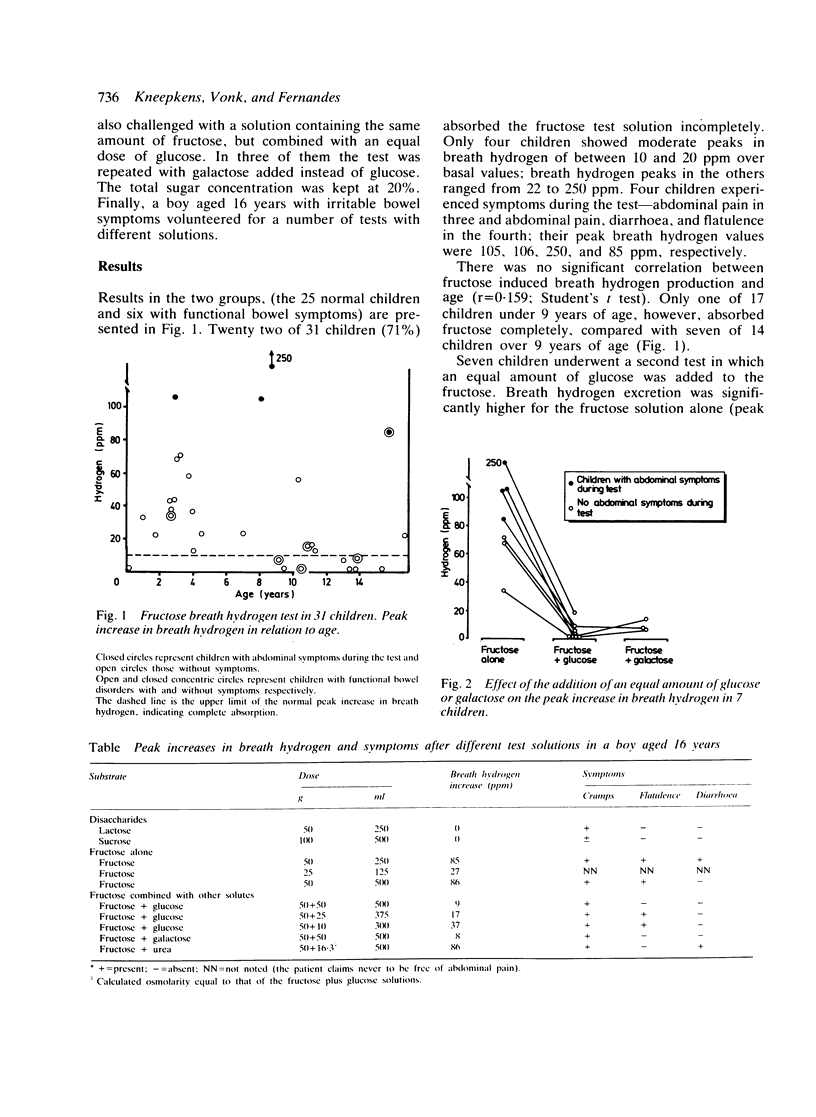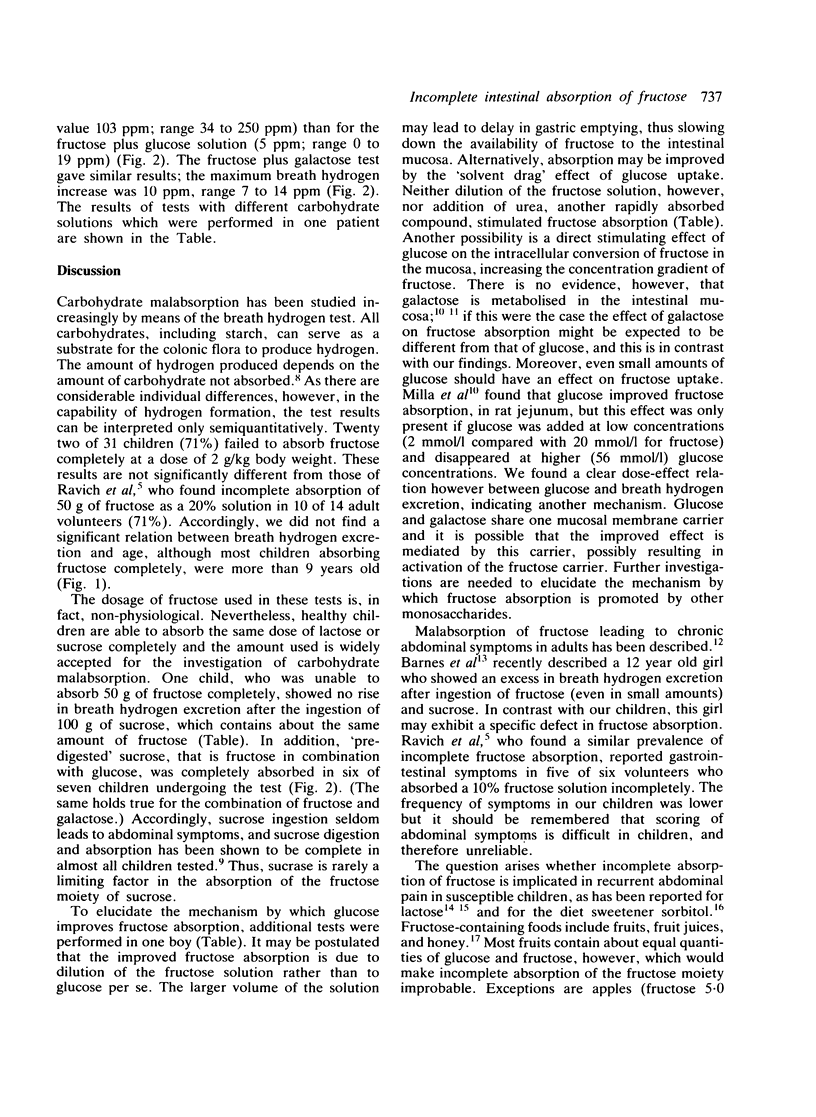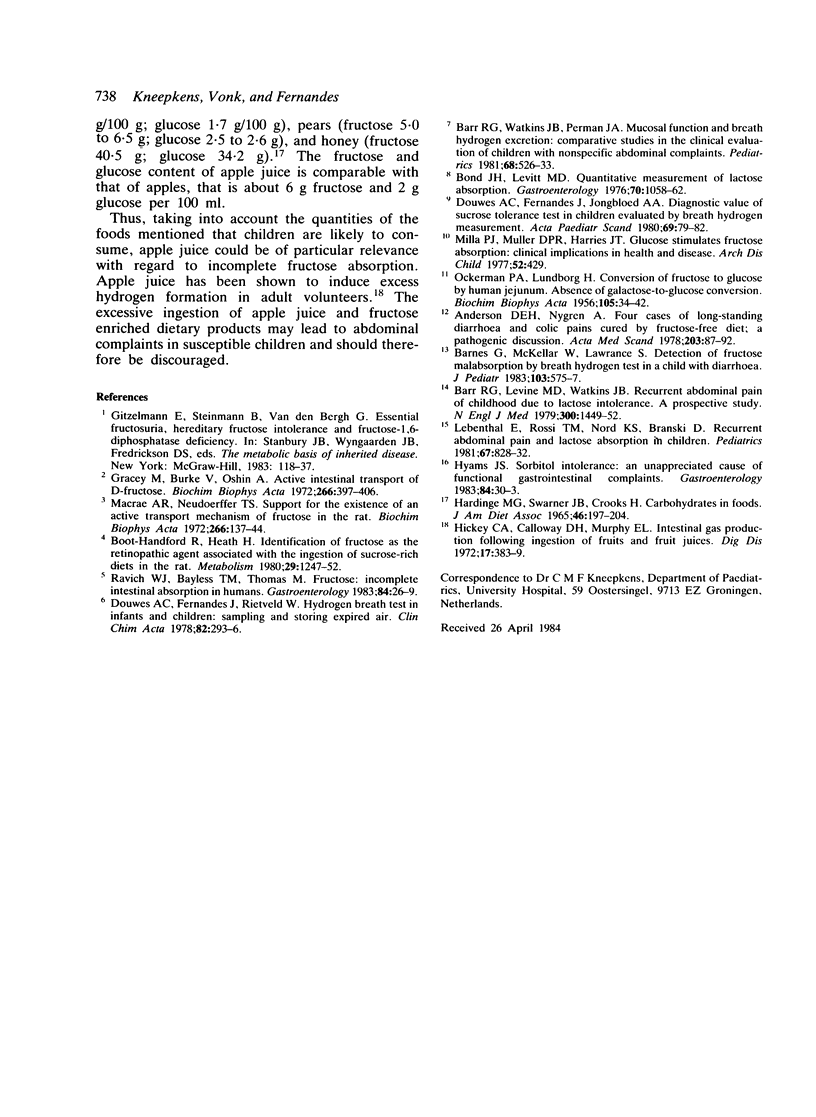Abstract
Intestinal D-fructose absorption in 31 children was investigated using measurements of breath hydrogen. Twenty five children had no abdominal symptoms and six had functional bowel disorders. After ingestion of fructose (2 g/kg bodyweight), 22 children (71%) showed a breath hydrogen increase of more than 10 ppm over basal values, indicating incomplete absorption: the increase averaged 53 ppm, range 12 to 250 ppm. Four of these children experienced abdominal symptoms. Three of the six children with bowel disorders showed incomplete absorption. Seven children were tested again with an equal amount of glucose, and in three of them also of galactose, added to the fructose. The mean maximum breath hydrogen increases were 5 and 10 ppm, respectively, compared with 103 ppm after fructose alone. In one boy several tests were performed with various sugars; fructose was the only sugar incompletely absorbed, and the effect of glucose on fructose absorption was shown to be dependent on the amount added. It is concluded that children have a limited absorptive capacity for fructose. We speculate that the enhancing effect of glucose and galactose on fructose absorption may be due to activation of the fructose carrier. Apple juice in particular contains fructose in excess of glucose and could lead to abdominal symptoms in susceptible children.
Full text
PDF



Selected References
These references are in PubMed. This may not be the complete list of references from this article.
- Andersson D. E., Nygren A. Four cases of long-standing diarrhoea and colic pains cured by fructose-free diet--a pathogenetic discussion. Acta Med Scand. 1978;203(1-2):87–92. doi: 10.1111/j.0954-6820.1978.tb14836.x. [DOI] [PubMed] [Google Scholar]
- Barnes G., McKellar W., Lawrance S. Detection of fructose malabsorption by breath hydrogen test in a child with diarrhea. J Pediatr. 1983 Oct;103(4):575–577. doi: 10.1016/s0022-3476(83)80588-5. [DOI] [PubMed] [Google Scholar]
- Barr R. G., Levine M. D., Watkins J. B. Recurrent abdominal pain of childhood due to lactose intolerance. N Engl J Med. 1979 Jun 28;300(26):1449–1452. doi: 10.1056/NEJM197906283002602. [DOI] [PubMed] [Google Scholar]
- Barr R. G., Watkins J. B., Perman J. A. Mucosal function and breath hydrogen excretion: comparative studies in the clinical evaluation of children with nonspecific abdominal complaints. Pediatrics. 1981 Oct;68(4):526–533. [PubMed] [Google Scholar]
- Bond J. H., Levitt M. D. Quantitative measurement of lactose absorption. Gastroenterology. 1976 Jun;70(6):1058–1062. [PubMed] [Google Scholar]
- Boot-Handford R., Heath H. Identification of fructose as the retinopathic agent associated with the ingestion of sucrose-rich diets in the rat. Metabolism. 1980 Dec;29(12):1247–1252. doi: 10.1016/0026-0495(80)90153-5. [DOI] [PubMed] [Google Scholar]
- Douwes A. C., Fernandes J., Jongbloed A. A. Diagnostic value of sucrose tolerance test in children evaluated by breath hydrogen measurement. Acta Paediatr Scand. 1980 Jan;69(1):79–82. doi: 10.1111/j.1651-2227.1980.tb07034.x. [DOI] [PubMed] [Google Scholar]
- Douwes A. C., Fernandes J., Rietveld W. Hydrogen breath test in infants and children: sampling and storing expired air. Clin Chim Acta. 1978 Jan 16;82(3):293–296. doi: 10.1016/0009-8981(78)90013-x. [DOI] [PubMed] [Google Scholar]
- Gracey M., Burke V., Oshin A. Active intestinal transport of D-fructose. Biochim Biophys Acta. 1972 May 9;266(2):397–406. doi: 10.1016/0005-2736(72)90096-x. [DOI] [PubMed] [Google Scholar]
- HARDINGE M. G., SWARNER J. B., CROOKS H. CARBOHYDRATES IN FOODS. J Am Diet Assoc. 1965 Mar;46:197–204. [PubMed] [Google Scholar]
- Hickey C. A., Calloway D. H., Murphy E. L. Intestinal gas production following ingestion of fruits and fruit juices. Am J Dig Dis. 1972 May;17(5):383–389. doi: 10.1007/BF02231287. [DOI] [PubMed] [Google Scholar]
- Hyams J. S. Sorbitol intolerance: an unappreciated cause of functional gastrointestinal complaints. Gastroenterology. 1983 Jan;84(1):30–33. [PubMed] [Google Scholar]
- Lebenthal E., Rossi T. M., Nord K. S., Branski D. Recurrent abdominal pain and lactose absorption in children. Pediatrics. 1981 Jun;67(6):828–832. [PubMed] [Google Scholar]
- Macrae A. R., Neudoerffer T. S. Support for the existence of an active transport mechanism of fructose in the rat. Biochim Biophys Acta. 1972 Oct 23;288(1):137–144. doi: 10.1016/0005-2736(72)90231-3. [DOI] [PubMed] [Google Scholar]
- Ockerman P. A., Lundborg H. Conversion of fructose to glucose by human jejunum absence of galactose-to-glucose conversion. Biochim Biophys Acta. 1965 Jul 29;105(1):34–42. doi: 10.1016/s0926-6593(65)80173-4. [DOI] [PubMed] [Google Scholar]
- Ravich W. J., Bayless T. M., Thomas M. Fructose: incomplete intestinal absorption in humans. Gastroenterology. 1983 Jan;84(1):26–29. [PubMed] [Google Scholar]


